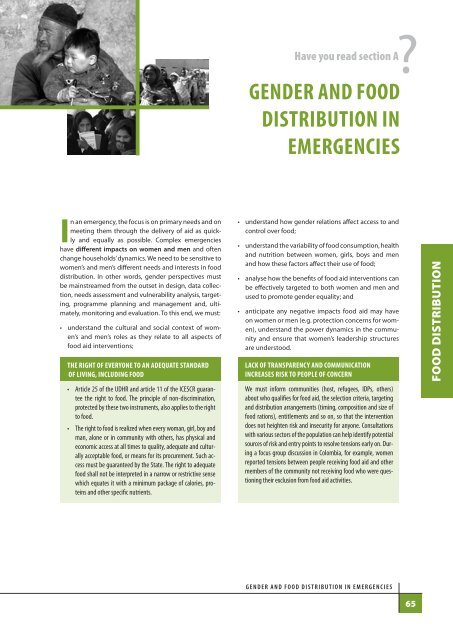Women, Girls, Boys and men - HumanitarianInfo.org
Women, Girls, Boys and men - HumanitarianInfo.org
Women, Girls, Boys and men - HumanitarianInfo.org
Create successful ePaper yourself
Turn your PDF publications into a flip-book with our unique Google optimized e-Paper software.
In an emergency, the focus is on primary needs <strong>and</strong> on<br />
meeting them through the delivery of aid as quickly<br />
<strong>and</strong> equally as possible. Complex emergencies<br />
have different impacts on wo<strong>men</strong> <strong>and</strong> <strong>men</strong> <strong>and</strong> often<br />
change households’ dynamics. We need to be sensitive to<br />
wo<strong>men</strong>’s <strong>and</strong> <strong>men</strong>’s different needs <strong>and</strong> interests in food<br />
distribution. In other words, gender perspectives must<br />
be mainstreamed from the outset in design, data collection,<br />
needs assess<strong>men</strong>t <strong>and</strong> vulnerability analysis, targeting,<br />
programme planning <strong>and</strong> manage<strong>men</strong>t <strong>and</strong>, ultimately,<br />
monitoring <strong>and</strong> evaluation. To this end, we must:<br />
• underst<strong>and</strong> the cultural <strong>and</strong> social context of wo<strong>men</strong>’s<br />
<strong>and</strong> <strong>men</strong>’s roles as they relate to all aspects of<br />
food aid interventions;<br />
the rIght oF everyone to An ADequAte stAnDArD<br />
oF lIvIng, IncluDIng FooD<br />
• article 25 of the udhr <strong>and</strong> article 11 of the iCesCr guarantee<br />
the right to food. the principle of non-discrimination,<br />
protected by these two instru<strong>men</strong>ts, also applies to the right<br />
to food.<br />
• the right to food is realized when every woman, girl, boy <strong>and</strong><br />
man, alone or in community with others, has physical <strong>and</strong><br />
economic access at all times to quality, adequate <strong>and</strong> culturally<br />
acceptable food, or means for its procure<strong>men</strong>t. such access<br />
must be guaranteed by the state. the right to adequate<br />
food shall not be interpreted in a narrow or restrictive sense<br />
which equates it with a minimum package of calories, proteins<br />
<strong>and</strong> other specific nutrients.<br />
?<br />
Have you read section A<br />
genDer AnD FooD<br />
DIstrIbutIon In<br />
emergencIes<br />
• underst<strong>and</strong> how gender relations affect access to <strong>and</strong><br />
control over food;<br />
• underst<strong>and</strong> the variability of food consumption, health<br />
<strong>and</strong> nutrition between wo<strong>men</strong>, girls, boys <strong>and</strong> <strong>men</strong><br />
<strong>and</strong> how these factors affect their use of food;<br />
• analyse how the benefits of food aid interventions can<br />
be effectively targeted to both wo<strong>men</strong> <strong>and</strong> <strong>men</strong> <strong>and</strong><br />
used to promote gender equality; <strong>and</strong><br />
• anticipate any negative impacts food aid may have<br />
on wo<strong>men</strong> or <strong>men</strong> (e.g. protection concerns for wo<strong>men</strong>),<br />
underst<strong>and</strong> the power dynamics in the community<br />
<strong>and</strong> ensure that wo<strong>men</strong>’s leadership structures<br />
are understood.<br />
lAck oF trAnspArency AnD communIcAtIon<br />
IncreAses rIsk to people oF concern<br />
We must inform communities (host, refugees, idps, others)<br />
about who qualifies for food aid, the selection criteria, targeting<br />
<strong>and</strong> distribution arrange<strong>men</strong>ts (timing, composition <strong>and</strong> size of<br />
food rations), entitle<strong>men</strong>ts <strong>and</strong> so on, so that the intervention<br />
does not heighten risk <strong>and</strong> insecurity for anyone. Consultations<br />
with various sectors of the population can help identify potential<br />
sources of risk <strong>and</strong> entry points to resolve tensions early on. during<br />
a focus group discussion in Colombia, for example, wo<strong>men</strong><br />
reported tensions between people receiving food aid <strong>and</strong> other<br />
members of the community not receiving food who were questioning<br />
their exclusion from food aid activities.<br />
G e n d e R A n d F o o d d I S T R I b u T I o n I n e m e R G e n C I e S<br />
FOOD DiSTRiBuTiOn











